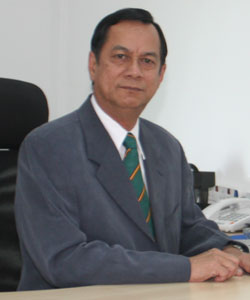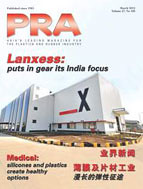 |
 |
In this Edition February 2012 |
LEAD FEATURE |
COMPANY NEWS |
MATERIALS NEWS |
MACHINERY NEWS |
INJECTION MOULDING ASIA |
RUBBER JOURNAL ASIA |
PRA March 2012 Electronic Issue Now Available |
Lead Feature
Composites suppliers falling down a rabbit hole in ASEAN
 |
Amongst the reasons he gave is that not much high-end work is being undertaken in the ASEAN - a region made up of ten countries: Philippines, Vietnam, Laos, Cambodia, Myanmar, Thailand, Malaysia, Singapore, Indonesia and Brunei, with a collective population of 500 million.
Opportunities for growth available
Habibur said that a bulk of the work undertaken in the region comprises low-value (glassfibre reinforced plastics) GFRP products that are not of world-class standards. He qualified "world-class" as GFRP products that meet standards and quality specifications imposed in Europe, US and Australia. He said that technology, process and use of new raw materials, machinery and processes needed to be improved in ASEAN countries.
"The potential for high-end advanced composites is big, but more work needs to be done in educating users in the marine, building, transport and rail industries in these countries." He lamented that architects, in particular, were not as well informed about the use of composites and also pointed out that specifiers, government legislators and consumers needed to be educated about the benefits of using composites in lieu of aluminium, steel and wood.
"Boat yards still use age-old methods of chop strand glass fibre for fishing boat hulls. The use of cheap fibreglass for buses and truck cabs do not meet safety standards. Most of these are simply replacements for metal and wood and not for safety and durability. Prices are low and so are profits margins."
Fabrication in the region
In the region, Thailand, Malaysia and the Philippines have fabricators and some raw material manufacturers. Thailand leads with 70 GFRP fabricators, mainly involved in the automotive and marine sectors. Malaysia trails behind but it has less than 15 fabricators, catering to components for the aerospace, rail and building sectors. The Philippines has also started seeing some fabrication, a result of the "low labour costs and educated human resources."
But Habibur says that though the rest of ASEAN, and in particular Indonesia, has huge potential for GFRP usage, "it has not shown much by way of using this technology. More investments are needed and I believe this will be done in the coming years as Indonesia starts to improve its manufacturing base towards high-value products."
And though Vietnam has a fast growing boat building industry with new investments and relocations from established foreign shipyards, little has been done in GFRP hulls of any high standards.
As for Myanmar, Habibur said, "It will want to play catch-up and may be advised to leapfrog from traditional to new methods of fabricating boat hulls by using composites. The country's labour rates are probably the lowest in ASEAN now. A lot will depend on how fast the confidence levels by foreign investors reach to the point of real money flowing in. I expect this will start after the new government is in place and has gained acceptance by its ASEAN neighbours. I expect Myanmar to be a competitive nation within ten years."
Habibur also pointed out that universities are beginning to offer courses in material sciences and composites, with Singapore ahead in its knowledge base on high-value products. The National University of Singapore is one such institution that caters to R&D on composites sciences.
Malaysia, Thailand and the Philippines are also catching up. "Malaysian government agencies provide grants and support the aerospace and rail transport sectors."
Future growth
Habibur, who is also the Executive Director of composites products fabricator DK Composites, based his paper on his experiences of operating the company, which is a German-Malaysian joint venture established in Malacca since 1997 as a fabricator of large domes and sailing boats. "Our work has included development of process and human resources skills and has led us to participate in the fabrication of train exteriors and interiors using advanced composites and prepregs."
He also said that for many years, DK Composites had little or no competition in Southeast Asia but competition was growing.
As for the future of the industry, he pointed out that economies of scale were needed for fabricators to remain competitive. "Due to the bulky nature of the end products GFRP parts have to be fabricated to fit standard 40 ft containers if they are to be exported by sea shipment. Therefore, design and fabrication planners have these parameters to observe. Fabricators in Southeast Asia need to consider shipping costs to the more lucrative markets in the Gulf countries, Australia, US and Europe. This reach into global markets will be needed to attain economies of scale and production volume to keep prices low."
Other factors that will drive the future of the industry include innovation, use of new materials and enhancement of skills. "In order to remain competitive, fabricators in ASEAN countries must attain a balance between quality and price, something that is ever changing due to costs of imported raw materials and machinery, which must be shipped across from US, Europe and the more distant Asian countries like Japan, Korea and China. ASEAN-based fabricators who enjoy sales into these markets have been able to meet these challenges. There are many success stories," he added.


